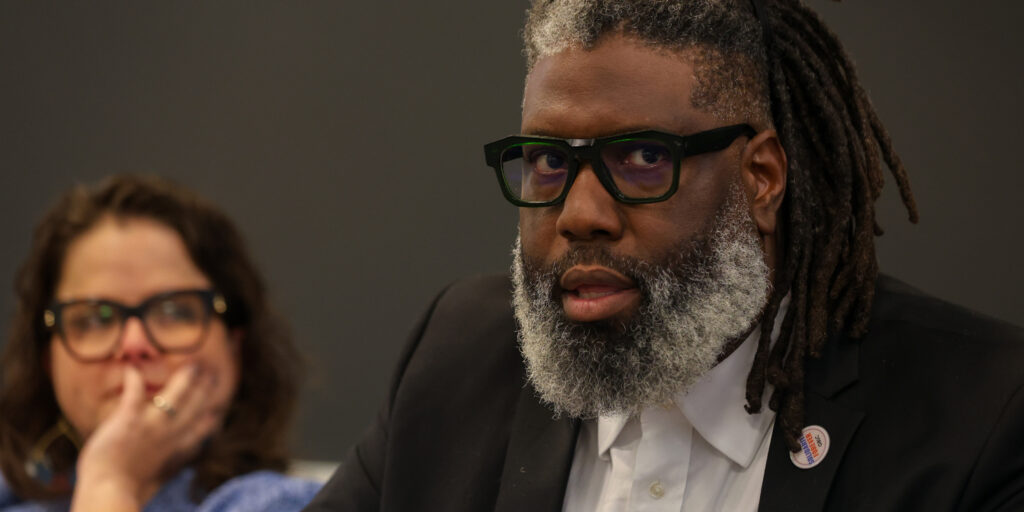The environmental justice movement works at the intersection of racial justice and climate change, and “comes from struggle,” said a participant in the Rappaport Center for Law and Public Policy’s first panel discussion of the semester on September 5. Members of organizations in the field shared their experiences in seeking that justice.
Penn Loh, distinguished senior lecturer of urban and environmental policy and planning at Tufts University, moderated the panel, “Frontline Solutions Towards a Just Transition.” “The communities that are most affected are the ones that have to lead the way to the solutions,” he said.
Elizabeth Yeampierre, the first of two Rappaport 2024 Rappaport Senior Fellows and the director of UPROSE, a community organization with a focus on sustainability, resilience, and advocacy in Brooklyn, NY, expanded on that observation. She said that she was inspired to do this work by her own childhood upbringing. As a Puerto Rican, and of African and indigenous descent, she lived in homes filled with lead in the “shadow” of power plants.
“I grew up in an environmental justice community, and all of the health impacts that happened to our communities live in my body and the bodies of my people and my family, and so this fight for justice in the environmental and climate arena is very personal to all of us,” Yeampierre said. “This is not something we studied and decided that we were going to become contemporary saviors or missionaries and go and help another community.”
Speakers included María Belén Power, undersecretary of environmental justice and equity at the Massachusetts Executive Office of Energy and Environmental Affairs (EEA), a state cabinet-level office that oversees environmental and energy agencies. Born and raised in Nicaragua, Belén Power said she grew up seeing social and economic inequalities firsthand.
Prior to working at the EEA, Belén Power founded GreenRoots, Inc., an environmental justice organization in Chelsea and East Boston, where she worked for six years. In her early work, she realized communities suffering from wage theft or deportations were also suffering from environmental burdens such as high rates of asthma and cardiovascular disease. “When I look at who has access [to the EEA] and who do people [in government] gut-check with, it’s pretty obvious that the most vulnerable residents are not the first folks that we’re gut checking with,” she said.
“We need lawyers. We need them smart. We need them aggressive. We need them in the movement.”
Dwaign Tyndal
Belén Power contends that the Green New Deal’s “unprecedented” amount of funds provide agencies with the opportunity to either exacerbate the challenges that low-income communities and communities of color face, or help make a difference. “We can reduce emissions’ overall average at the state and still increase pollution in the Chelseas and Roxburys of the state, and so just looking at our large picture, big picture goals is just not enough. What does it look like on the ground in these communities?”
Dwaign Tyndal, executive director of Alternatives for Community and Environment (ACE), believes lawyers will be the “linchpin ” as environmental justice organizations and frontline communities confront challenges and adjust to policy. “We need lawyers. We need them smart. We need them aggressive. We need them in the movement. Our movement will not survive in the next ten, fifteen, years without great lawyers,” he said.
Tyndal cited Boston’s Building Emissions Reduction and Disclosure Ordinance (BERDO), which reduces emissions on buildings larger than 20,000 square feet, as an example of community lawyering helping create change. “This ordinance that we passed in the city of Boston, now we are working with Senator [Edward] Markey ’72 because they want to use the BERDO as a framework for federal legislations on building emissions,” Tyndal said. “The work we do actually matters.”
Community lawyering is especially important, Tyndal said, as more money is directed towards making companies green. “Our concern is not just for the environment, but about the human beings that are impacted by this new investment,” he explained. “And greener does not mean better for our communities. Sometimes it may be just the opposite. So, we [all] look gift horses in the mouth.”
Expanding on her earlier comments, Yeampierre argued that lawyers interested in environmental justice need to be committed to allyship and solidarity. “If you recognize the fact that climate change is not open to discussion, and you want to do something that is purposeful and meaningful, you want to be about that life, then you support the work that is being held by our organizations. You don’t build new ones. You do some landscaping to find out who’s doing the work,” and ask: “How can I add value, how can I serve?”
Photograph by Reba Saldanha


